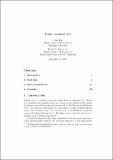| dc.contributor.author | Han, Gang | |
| dc.contributor.author | Vogan, David A | |
| dc.date.accessioned | 2018-06-06T18:22:44Z | |
| dc.date.available | 2018-06-06T18:22:44Z | |
| dc.date.issued | 2014-12 | |
| dc.identifier.isbn | 978-1-4939-1589-7 | |
| dc.identifier.isbn | 978-1-4939-1590-3 | |
| dc.identifier.issn | 0743-1643 | |
| dc.identifier.issn | 2296-505X | |
| dc.identifier.uri | http://hdl.handle.net/1721.1/116150 | |
| dc.description.abstract | We define a “finite maximal torus” of a compact Lie group G to be a maximal finite abelian subgroup A of G. We introduce structure for finite maximal tori parallel to the classical structure for maximal tori, like roots and the Weyl group; and we recall a large number of (previously known) examples. Keywords: Compact group; Maximal finite abelian subgroup | en_US |
| dc.publisher | Springer | en_US |
| dc.relation.isversionof | http://dx.doi.org/10.1007/978-1-4939-1590-3_10 | en_US |
| dc.rights | Creative Commons Attribution-Noncommercial-Share Alike | en_US |
| dc.rights.uri | http://creativecommons.org/licenses/by-nc-sa/4.0/ | en_US |
| dc.source | MIT Web Domain | en_US |
| dc.title | Finite maximal tori | en_US |
| dc.type | Article | en_US |
| dc.identifier.citation | Han, Gang, and David A. Vogan. “Finite Maximal Tori.” Progress in Mathematics (2014): 269–303 © 2014 Springer Science+Business Media New York | en_US |
| dc.contributor.department | Massachusetts Institute of Technology. Department of Mathematics | en_US |
| dc.contributor.mitauthor | Vogan, David A | |
| dc.relation.journal | Symmetry: Representation Theory and Its Applications | en_US |
| dc.eprint.version | Original manuscript | en_US |
| dc.type.uri | http://purl.org/eprint/type/JournalArticle | en_US |
| eprint.status | http://purl.org/eprint/status/NonPeerReviewed | en_US |
| dc.date.updated | 2018-05-31T17:03:16Z | |
| dspace.orderedauthors | Han, Gang; Vogan, David A. | en_US |
| dspace.embargo.terms | N | en_US |
| dc.identifier.orcid | https://orcid.org/0000-0002-9816-2395 | |
| mit.license | OPEN_ACCESS_POLICY | en_US |
